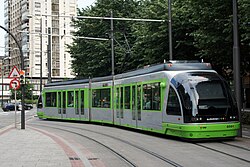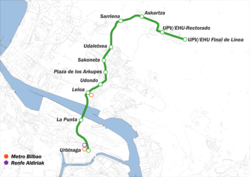| Euskotren Tranbia | |
|---|---|
 | |
 A 400 series tram in Bilbao. | |
| Overview | |
| Locale | Bilbao, Vitoria-Gasteiz (Basque Country, Spain) |
| Transit type | Tram |
| Annual ridership | |
| Headquarters |
|
| Website | www |
| Operation | |
| Began operation |
|
| Operator(s) | Euskotren |
| Technical | |
| Track gauge | 1,000 mm (3 ft 3+3⁄8 in) metre gauge |
| Electrification | 750 V DC overhead catenary |
Euskotren Tranbia[a] is the brand under which the tramway networks in the cities of Vitoria-Gasteiz and Bilbao (both in the Basque Country, Spain) are run. The system in Bilbao started operations in 2002, and the one in Vitoria-Gasteiz in 2008. It is one of the four commercial divisions under which Euskotren (a public company managed by the Basque Government) operates. The infrastructure is owned by the public entity Euskal Trenbide Sarea (Basque Railway Network)[4] and tracks use 1,000 mm (3 ft 3+3⁄8 in) narrow gauge.[citation needed]
Services[edit]

Euskotren Tranbia operates tram networks in Vitoria-Gasteiz (province of Álava) and Bilbao (province of Biscay). The first network, then named EuskoTran started operations in Bilbao in 2002 after two years under construction, connecting Bilbao-Atxuri Station with Uribitarte.[5] The line was eventually expanded to the Guggenheim Museum Bilbao,[6] Basurto Hospital[7] and finally La Casilla.[8]
The tramway system in Vitoria-Gasteiz opened in 2008 and has a Y-shaped network, with two different lines that cross the city from south to north.[9]
Trams run on the street (shared with other traffic or on dedicated tracks) and on grass tracks.[citation needed] It also shares dedicated lanes with the local bus services, TUVISA in Vitoria-Gasteiz and Bilbobus in Bilbao.[citation needed]
Stop design[edit]

The two tram systems have their own, distinguishable stops, some of them shared with bus systems and with low platforms. The stops of Atxuri, Ribera and Abando, all of them in Bilbao, do not have a dedicated platform, they use the sidewalk. Except for Atxuri, all stops are unstaffed and rely on automated ticket machines. All the stations have displays and screens with the network map, the current time and temperature and the frequencies. Due to the low platforms, the access between them involves crossing the tracks by pedestrian level crossing. They are virtually level with the doors and are all wider than 2 m (6.6 ft). This allows wheelchairs, prams, pushchairs and the elderly to board the tram easily with no steps. In street sections, the pavement is integrated with the tram stop.[citation needed] The system in Bilbao has 14 stops, while the one in Vitoria has 23.[10]
Systems[edit]

Bilbao[edit]
Vitoria-Gasteiz[edit]
Fares and ticketing[edit]
The two systems use both regular paper tickets and smartcards (BAT, Barik and Mugi). There are single, daily and monthly tickets available.[11] In both networks, ticket pricing is not based on zone-based rules, as there's a unique fare for the whole of each network.
Rolling stock[edit]
Euskotren Tranbia operates a fleet of 26 CAF Urbos trams, distributed between both networks.
Current fleet[edit]
| Class | Image | Number | Network | In service | Notes |
|---|---|---|---|---|---|
| 400 series (CAF Urbos 1) | 
|
8 | Bilbao | 2002–present | |
| 500 series (CAF Urbos 2) | 
|
11 | Bilbao, Vitoria-Gasteiz | 2008–present | 3 in Bilbao[12] 8 in Vitoria-Gasteiz |
| 600 series (CAF Urbos 3) | 7 | Vitoria-Gasteiz | 2020–present |
The 400 series consists of 8 vehicles (numbered 401-408),[13] built for the Bilbao network. The trams are 24.4 m (80 ft) long, have 70% low floor access and are made up of three cars. Each tram can carry 196 passengers.[14] They are the only CAF Urbos 1 trams to have been built.[15]
The 500 series consists of 11 vehicles (numbered 501-511), originally built for the Vitoria-Gasteiz network.[16] The trams are 31.4 m (103 ft) long, have 100% low floor access and are made up of five cars. Each tram can carry 261 passengers.[17] Due to the introduction of the larger 600 series in Vitoria-Gasteiz, three vehicles will be transferred to Bilbao.[18]
The 600 series consists of 7 vehicles[12][19] (numbered 601-607), built for the Vitoria-Gasteiz network. The trams are 44.2 m (145 ft) long, have 100% low floor access and are made up of seven cars. Each tram can carry 398 passengers.[17]
Livery[edit]
The trams were originally painted in grey and green stripes, the colours of Euskotren Tranbia. The current livery is white and green.[citation needed]
Planned developments[edit]
Bilbao[edit]
Vitoria-Gasteiz[edit]
Shelved projects[edit]
Barakaldo tram[edit]
There were plans to create a tram network in the municipality of Barakaldo, in the Greater Bilbao area, which would have started in Urbinaga (where it would have been connected to the Leioa tram) and from there create a circular line around the city center. The project included fifteen stops within Barakaldo plus two in Sestao, where it would connect with the Leioa line.[citation needed] Even if this project hasn't been officially canceled, no progress has been made since 2010.[20]
Leioa tram[edit]

The construction of a tramway for the municipality of Leioa, in the Greater Bilbao area had two phases. The first phase consisted in the construction of the depot and offices. The second phase would have involved the line itself including the rail track and stops from the University of the Basque Country campus to downtown Leioa. It would have included nine stops. A third phase would have made the tramway cross the Estuary of Bilbao and connect Leioa with the Left Bank with two extra stations.[citation needed]
Only the first phase (the depot and offices) has been built. After being postponed several times, the project was shelved in 2018.[21]
See also[edit]
Notes[edit]
References[edit]
- ^ "El tranvía de Bilbao se prepara para poder operar con unidades más largas". Deia.eus (in Spanish). 27 April 2019. Retrieved 2 December 2019.
- ^ "El tranvía de Vitoria cumple 10 años con el 90% de los viajeros satisfecheos". Diario Vasco (in Spanish). 21 December 2018. Retrieved 2 December 2019.
- ^ "What is Euskotren?". euskotren.eus. Retrieved 15 May 2021.
- ^ Euskal Trenbide Sarea - Memoria 2019 (PDF). euskadi.eus (Report) (in Spanish). p. 138. Retrieved 15 May 2021.
- ^ Eguinoa, Aitor (18 December 2002). "El tranvía se inaugura hoy en Bilbao 47 años después de su desaparición". El País (in Spanish). Retrieved 15 May 2021.
- ^ "Programa tranviario: tranvía de Bilbao, tranvía de Vitoria-Gasteiz, tranvía Urbinaga-Leioa-Universidad, tranvía del Deba". euskadi.eus (in Spanish). Basque Government. Retrieved 15 May 2021.
- ^ "El tranvía de Bilbao llega a San Mamés aunque se mantiene su escaso uso". El País (in Spanish). 25 July 2003. Retrieved 15 May 2021.
- ^ "El tranvía de Bilbao está de cumpleaños". El Mundo (in Spanish). EFE. 18 December 2012. Retrieved 15 May 2021.
- ^ "Travelling by tram - Timetables and routes". Vitoria-Gasteiz City Council. Retrieved 15 May 2021.
- ^ "Así es el recorrido de la nueva ampliación del tranvía hasta el Campus Universitario". EITB (in Spanish). 17 February 2020. Retrieved 15 May 2021.
- ^ "Tickets". euskotren.eus. Retrieved 15 May 2021.
- ^ a b "Material móvil". euskotren.eus (in Spanish). 19 March 2021.
- ^ Peris Torner, Juan (12 February 2015). "Tranvías de Bilbao, desde 2003 (tranvía de la 2ª generación)". Spanish Railway (in Spanish). Retrieved 11 April 2015.
- ^ "Bilbao tram". CAF. Retrieved 15 May 2021.
- ^ "Urbos3, la nueva generación de tranvías" (PDF). Vía Libre (in Spanish). May 2009. Archived from the original (PDF) on 2010-06-24. Retrieved 15 May 2021.
- ^ Peris Torner, Juan (8 August 2014). "Tranvias de Vitoria-Euskotren Trambia". Spanish Railway (in Spanish). Retrieved 15 May 2021.
- ^ a b "Vitoria tram". CAF. Retrieved 15 May 2021.
- ^ "Los tranvías largos circularán por Bilbao en abril de 2020". Deia (in Spanish). 3 October 2019. Retrieved 15 May 2021.
- ^ Bravo, Oier (19 March 2021). "Vitoria-Gasteiz ya tiene sus siete tranvías extralargos". GasteizHoy (in Spanish). Retrieved 15 May 2021.
- ^ Segovia, Josu (17 February 2016). "Tranvía en vía muerta". Cadena SER (in Spanish). Retrieved 15 May 2021.
- ^ Basterra, Terry (22 February 2018). "El Parlamento aprueba estudiar otras alternativas al tranvía de Leioa para conectar el metro y la UPV". El Correo (in Spanish). Retrieved 15 May 2021.